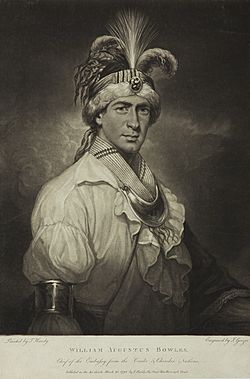Maryland Loyalists Battalion facts for kids
Quick facts for kids Maryland Loyalists Battalion |
|
|---|---|

William Augustus Bowles, who some sources erroneously believe was also the pirate "Billy Bowlegs", was an ensign in the Maryland Loyalists Battalion.
|
|
| Active | 1777–1783 |
| Country | Britain |
| Allegiance | Britain |
| Branch | British provincial unit |
| Type | infantry, (auxiliary troops) |
| Size | battalion (300-500) |
| Garrison/HQ | Pensacola, West Florida |
| Nickname(s) | First Battalion of Maryland Loyalists |
| Engagements | American Revolutionary War
|
| Commanders | |
| Notable commanders |
|
The Maryland Loyalists Battalion was a special British army unit during the American Revolutionary War. It was made up of American colonists who stayed loyal to Britain. Sometimes, it was called the First Battalion of Maryland Loyalists. This unit fought for Britain from 1777 to 1783.
Contents
Maryland and the American Revolution
During the American Revolution, the colony of Maryland was deeply divided. Some people wanted independence from Britain, while others wanted to remain loyal. Many important leaders in Maryland chose to stay loyal to the British King.
For example, Benedict Swingate Calvert was a judge and part of a powerful family. He remained loyal to Britain. Because he was on the losing side of the war, he lost his political power. After the war, Loyalists like him faced difficulties. They had to pay higher taxes and sign a special loyalty oath. Many also lost their land and property.
History of the Battalion
The Maryland Loyalists Battalion was formed in October 1777 in Philadelphia. At that time, Philadelphia was controlled by the British. Most of the soldiers came from the Eastern Shore of Maryland.
The unit's leader was Lt. Col. James Chalmers. He was from Chestertown, Maryland. Chalmers was also a writer who strongly supported the British cause.
Battles and Challenges
The Maryland Loyalists fought in the Battle of Monmouth in 1778. This was a limited battle for them. Later that year, they were sent to Pensacola, in West Florida. Their mission there was to fight against the Spanish.
When they arrived in Pensacola, many soldiers got sick with smallpox and died. This made the unit much weaker. In 1781, the Spanish attacked Pensacola in what was called the siege of Pensacola. The weakened Maryland Loyalists were defeated.
After the defeat, the soldiers became prisoners of war in Cuba for a short time. Then, they were sent back to New York City, which was the main British base during the war.
Life After the War
After the American Revolutionary War ended, the British government helped many American Loyalists. They were moved to Nova Scotia in Canada as refugees. In 1783, a ship carrying some of these soldiers was wrecked off the coast of Nova Scotia.
The survivors of the shipwreck became some of the first British American citizens in the new Canadian province of New Brunswick.
Today, there is a group in Baltimore, Maryland, that reenacts the Maryland Loyalist Battalion. They help people learn about this part of history.
Notable Soldiers
William Augustus Bowles
William Augustus Bowles was a young officer, called an ensign, in the Maryland Loyalists Battalion. Later, in the 1790s, he became an important leader among the Creek Indians.
Philip Barton Key
Philip Barton Key was a captain in the Maryland Loyalists Battalion. After the war, he went to England to study law. He returned to Maryland in 1785 and became a lawyer.
Key was also involved in politics. He served in the Maryland House of Delegates and was even the Mayor of Annapolis from 1797 to 1798.
Reference/Suggested reading
- Andrews, Matthew Page, History of Maryland, Doubleday Doran & Co, New York, (1929)
- Maryland Loyalists in the American Revolution by M. Christopher New. Tidewater Publishers; Centreville, MD, 1996.

